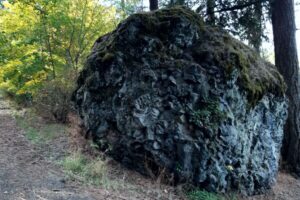 Q – Throughout the Spokane area there are what some call ‘haystacks’, basalt mounds that look like haystacks. There are many such on Spokane’s south hill and I’m including a photo of one that’s in lower Lincoln Park. How did these form? Do they indicate the location of a volcanic vent? – John Ludders
Q – Throughout the Spokane area there are what some call ‘haystacks’, basalt mounds that look like haystacks. There are many such on Spokane’s south hill and I’m including a photo of one that’s in lower Lincoln Park. How did these form? Do they indicate the location of a volcanic vent? – John Ludders
A1 – The picture is a large chunk of chill zone basalt. The sequence is chill zone, columnar basalt, entablature, capped by chill zone of the next flow. Like the columns, the chill zone is resistant to plucking but is weak and susceptible to hammering and chipping from rocks in the flow. Many are huge but are basically made in place by chipping, not being carried by flow. – Jim Shelden
A2 – The basalt boulder appears to be a portion of the entablature portion of the basalt flow. This portion of the flow commonly worked on by the floodwaters is undercut and portions fall off and get rolled downstream. I have noted hundreds of these boulders in the Spokane area below basalt exposures (cliffs) especially along the north hills (north of Spokane River). They are analogous to the basalt boulders that are observed below Dry Falls (along Umatilla Rock-west side) as seen from the Dry Falls visitor center. The only difference is that the Spokane area gets more precipitation allowing ponderosa pines to grow around them. Also I am not aware that the Cordilleran Ice Sheet advanced south enough into the Spokane vicinity so the basalt boulders are not erratics or “haystack rocks” left after glacial melt. – Brent Cunderla